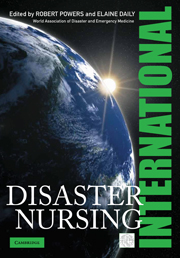Book contents
- Frontmatter
- FOREWORD I
- FOREWORD II
- Contents
- CONTRIBUTORS
- PREFACE
- ACKNOWLEDGMENTS
- CHAPTER 1 INTRODUCTION TO DISASTERS AND DISASTER NURSING
- CHAPTER 2 HEALTHCARE FACILITY PREPAREDNESS
- CHAPTER 3 COMMUNITY BEHAVIOR AND RESPONSE TO DISASTER
- CHAPTER 4 FIRST RESPONDERS
- CHAPTER 5 DISASTER TRIAGE
- CHAPTER 6 HOSPITAL IMPACT: EMERGENCY DEPARTMENT
- CHAPTER 7 HOSPITAL IMPACT: IMMEDIATE ISSUES
- CHAPTER 8 HOSPITAL IMPACT: LONG-TERM ISSUES
- CHAPTER 9 HOSPITAL IMPACT: INTERNAL DISASTERS
- CHAPTER 10 HEALTHCARE FACILITIES INCIDENT COMMAND
- CHAPTER 11 CHEMICAL PREPAREDNESS AND RESPONSE
- CHAPTER 12 BIOLOGICAL PREPAREDNESS AND RESPONSE
- CHAPTER 13 EMERGENCY MANAGEMENT OF RADIATION INJURIES AND ILLNESSES
- CHAPTER 14 EXPLOSIVE EVENT PREPAREDNESS/RESPONSE
- CHAPTER 15 DECONTAMINATION
- CHAPTER 16 POPULATIONS WITH VULNERABILITIES AND SPECIAL NEEDS
- CHAPTER 17 DISASTERS AND CHILDREN
- CHAPTER 18 REGIONAL PLANNING
- CHAPTER 19 US FEDERAL RESOURCES AND RESPONSE
- CHAPTER 20 INTERNATIONAL DISASTER RESPONSE
- CHAPTER 21 DISASTER NURSING RESPONSES IN JAPAN
- CHAPTER 22 PREPAREDNESS OF THE ISRAELI HEALTH SYSTEM FOR EMERGENCIES
- CHAPTER 23 PUBLIC HEALTH RESPONSE
- CHAPTER 24 PANDEMIC PLANNING
- CHAPTER 25 HEALTH ISSUES IN HUMANITARIAN EMERGENCIES
- CHAPTER 26 DISASTER MENTAL HEALTH
- CHAPTER 27 DISASTER ETHICS
- CHAPTER 28 DISASTER RECOVERY
- CHAPTER 29 THE SOUTHEAST ASIA TSUNAMI: HEALTH ASPECTS
- CHAPTER 30 HURRICANE KATRINA: HEALTH ASPECTS
- CHAPTER 31 DISASTER NURSING EDUCATIONAL COMPETENCIES
- CHAPTER 32 DISASTER NURSING RESEARCH
- CHAPTER 33 DISASTER RESEARCH FRAMEWORK
- INDEX
CHAPTER 19 - US FEDERAL RESOURCES AND RESPONSE
Published online by Cambridge University Press: 02 December 2010
- Frontmatter
- FOREWORD I
- FOREWORD II
- Contents
- CONTRIBUTORS
- PREFACE
- ACKNOWLEDGMENTS
- CHAPTER 1 INTRODUCTION TO DISASTERS AND DISASTER NURSING
- CHAPTER 2 HEALTHCARE FACILITY PREPAREDNESS
- CHAPTER 3 COMMUNITY BEHAVIOR AND RESPONSE TO DISASTER
- CHAPTER 4 FIRST RESPONDERS
- CHAPTER 5 DISASTER TRIAGE
- CHAPTER 6 HOSPITAL IMPACT: EMERGENCY DEPARTMENT
- CHAPTER 7 HOSPITAL IMPACT: IMMEDIATE ISSUES
- CHAPTER 8 HOSPITAL IMPACT: LONG-TERM ISSUES
- CHAPTER 9 HOSPITAL IMPACT: INTERNAL DISASTERS
- CHAPTER 10 HEALTHCARE FACILITIES INCIDENT COMMAND
- CHAPTER 11 CHEMICAL PREPAREDNESS AND RESPONSE
- CHAPTER 12 BIOLOGICAL PREPAREDNESS AND RESPONSE
- CHAPTER 13 EMERGENCY MANAGEMENT OF RADIATION INJURIES AND ILLNESSES
- CHAPTER 14 EXPLOSIVE EVENT PREPAREDNESS/RESPONSE
- CHAPTER 15 DECONTAMINATION
- CHAPTER 16 POPULATIONS WITH VULNERABILITIES AND SPECIAL NEEDS
- CHAPTER 17 DISASTERS AND CHILDREN
- CHAPTER 18 REGIONAL PLANNING
- CHAPTER 19 US FEDERAL RESOURCES AND RESPONSE
- CHAPTER 20 INTERNATIONAL DISASTER RESPONSE
- CHAPTER 21 DISASTER NURSING RESPONSES IN JAPAN
- CHAPTER 22 PREPAREDNESS OF THE ISRAELI HEALTH SYSTEM FOR EMERGENCIES
- CHAPTER 23 PUBLIC HEALTH RESPONSE
- CHAPTER 24 PANDEMIC PLANNING
- CHAPTER 25 HEALTH ISSUES IN HUMANITARIAN EMERGENCIES
- CHAPTER 26 DISASTER MENTAL HEALTH
- CHAPTER 27 DISASTER ETHICS
- CHAPTER 28 DISASTER RECOVERY
- CHAPTER 29 THE SOUTHEAST ASIA TSUNAMI: HEALTH ASPECTS
- CHAPTER 30 HURRICANE KATRINA: HEALTH ASPECTS
- CHAPTER 31 DISASTER NURSING EDUCATIONAL COMPETENCIES
- CHAPTER 32 DISASTER NURSING RESEARCH
- CHAPTER 33 DISASTER RESEARCH FRAMEWORK
- INDEX
Summary
TO PREVENT, prepare for, respond to, and recover from terrorist attacks, major disasters, and other emergencies, the United States Government shall establish a single, comprehensive approach to domestic incident management. The objective of the United States Government is to ensure that all levels of government across the Nation have the capability to work efficiently and effectively together, using a national approach to domestic incident management. In these efforts, with regard to domestic incidents, the United States Government treats crisis management and consequence management as a single, integrated function, rather than as two separate functions.”
Homeland Security Presidential Directive #5The United States faces the prospect of events — whether naturally occurring or deliberately caused — that may threaten its security, disrupt its economy, and imperil its citizens. Moreover, we know that despite efforts to prevent and protect against such events, their occurrence is inevitable. Disasters from natural causes (such as wildfires, earthquakes, floods, tornados, and hurricanes as well as human caused events, such as oil spills, hazardous materials releases, and industrial accidents, are facts of life that occur periodically. Within the United States, the events of 11 September 2001 and the anthrax attacks that followed serve as stark reminders of the vulnerability to intentional attacks instigated by those who aspire to harm that nation. The emergence of viruses, such as West Nile and Severe Acute Respiratory Syndrome (SARS), as well as the current threat of an H1N1 pandemic influenza, pose distinct, but related, challenges.
- Type
- Chapter
- Information
- International Disaster Nursing , pp. 335 - 350Publisher: Cambridge University PressPrint publication year: 2010



